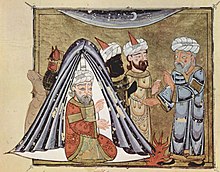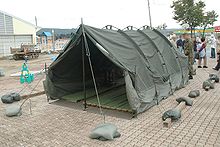tent
A tent is a light , often temporary structure, the shell of which is made of membranes ( mainly textile , tarpaulin , but also leather , foil, etc.). As a rule, a tent consists of this "tent skin" and a light, internal supporting structure (frame). The supporting structure usually consists of a skeleton of bars made of wood, bamboo, plastic or metal on the one hand and guy ropes on the other. Tents with a textile membrane are a form of textile architecture .
As far as tents are used as temporary architecture , their advantage is that they are easy to dismantle, relocate and transport.
Tents are used for the temporary stay of people, the storage of goods, as accommodation on trips and expeditions , as a meeting place or the residence of nomads . Festival tents are used as event halls for large events, and the circus tent is the traditional venue for a circus . Tents are also used by companies as sales areas at trade fairs and exhibitions or during special sales.
In addition, tent constructions are increasingly being used in contemporary architecture as permanent constructions.
history
After huts made of branches and leaves, tents are possibly the oldest form of human protective structures against the rigors of nature. Simple, small, easily transportable summer tents and more massive winter tents or spacious and stable carcasses (Gerippezelte) were already used in the Upper Palaeolithic . At most, the cover was taken away from the latter, the scaffolding could be used again in the next season if necessary. Dietrich Evers calculated around 40 horse skins with a total weight of 240 kg to cover a tent from Gönnersdorf . In the absence of pack animals and means of transport, the dwellings are unlikely to have been moved over long distances. The tents consisted of a frame made of wooden poles, over which animal skins were placed with the skin side facing outwards as a cover so that rainwater could easily run off. The edge of the tent was paved with sand, earth and stones. Presumably cords secured the tent against the wind.
With the advent of sedentarism , tents lost their importance; in areas where (semi) nomadism continued, however, they retained their importance.
With their different uses, tents continue to be found in numerous cultures - including North African and Asian nomads and North American Indians , some of whom lived exclusively in tents. Tents were used extensively in the military by the Romans . They are still used today as a medical tent , team accommodation or mobile workshops and situation centers, but are increasingly being replaced by containers.
At the beginning of the 20th century, with the advent of the folding boat sport as a mass sport, the modern tent including floor was also developed. The folding boat yards built tents like the skins of their boats: the top made of tightly woven cotton, the bottom made of rubber. The folding boat athletes had to rely on a tent because the rivers and lakes they traveled on were usually far from where they could stay overnight. And the fans of this sport invented the necessary accessories, such as Carl Joseph Luther the down sleeping bag and Hans Berger (Sport Berger company) the air mattress . Thus, until well into the 1950s, the manufacturers of tents and camping items were mainly folding boat yards such as Klepper or Pioneers.
Nowadays, the focus is on the use in camping holidays, in addition to commercial use as a festival, event and circus tent as well as private use as a party tent . In addition, civil engineering in the 19th and, above all, the 20th century developed bold permanent tent constructions, which are used again and again , especially in the architecture of the late 20th century and in contemporary architecture as flight roofs , as well as roof structures for permanent buildings and other structures and were able to establish themselves as a form of modern roof construction. In particular, the architect Frei Otto became known for such constructions, instead of flat tent sheets he sometimes uses rope nets that are filled with plastic elements (e.g. Olympic site in Munich ).
Technical development
Nowadays the tent skin consists of impregnated strips of fabric or plastic sheeting, and rods made of metal , plastic or wood are used as the supporting structure . In the past, animal skins , leather hides , leaves or the like were used as tent skin and bamboo, twigs or branches were used as the supporting structure. In rare cases, rope constructions are used that are stretched between existing objects.
In camping and trekking tents, there has been a trend for years towards increasingly lighter tents, which - like igloo tents - can also be set up easily.
A special construction are pneumatic constructions, the tent skin of which is held in place by an overpressure inside or by hoses filled with compressed air.
Tents are usually anchored to the ground with tent nails or pegs . They are increasingly standing on artificial ground, on tarpaulins or plates , on tent platforms , on pontoons and vehicles .
Leisure tent
Categories
The tents used as holiday accommodation during leisure time can be divided into the following categories (see also list of tent types ):
- Mini tents
- mostly in igloo or tunnel form with poles made of glass fiber reinforced plastic or aluminum . The materials used for the tent skin are almost exclusively nylon , polyester and polyurethane (PU) for the tent floor. Due to their low weight of 0.9 to 8 kilograms, they are mainly used for backpacking trips, cycling trips or motorcyclists . With their low height, they only offer space for sleeping and luggage. To improve the tent climate and reduce condensation, they are also made in two parts, with an inner and outer tent. With some tent designs, a so-called apse is created as a covered space outside the inner tent , in which equipment can be stored or cooked protected from the weather.
- Travel tents
- often in the form of a house tent with gable and ridge, recently also in the form of a tunnel. The materials for the tent skin correspond to those of the mini tents, steel is also used for the supporting structures. With a living area, they offer space for a longer stay. In the living area, there is often no floor, the roof is usually a double roof. Their weight is between 7 and 15 kilograms.
- Wall tents
- which are also suitable for a longer vacation. They have metal poles and the roof is often coated with PVC . The preferred materials for the side walls are cotton or blended fabrics. Inner tents suspended in the frame serve as separate sleeping compartments. They allow the inside of the tent to be used flexibly and the number of sleeping places to be adapted to requirements. Steep wall tents offer constant headroom. Equipped with a canopy, they offer additional protection against rain and sun. The weight is about 13 to 45 kilograms.
- Car roof tents
- represent a link between tent and mobile home. They are mounted on the roof of a vehicle. There is a compact package on the vehicle while driving. The tent that is set up comes in two main designs: tents that form a sleeping cabin on the roof of the car, and those that create additional living space next to the vehicle.
- Awnings
- are mounted on the door side of caravans and mobile homes . They serve as weather protection or to expand the living area.
- Tent trailer
- (also folding caravans ) are similar to car roof tents. A large tent can be folded out or down from a trailer, creating a large bedroom and living room. Combined with an awning, room dimensions of up to 30 square meters can be achieved. Due to the low weight of up to 300 kilograms, the trailer can also be pulled by small cars, depending on the product, payloads of up to 700 kilograms are possible. The tents are made of strong cotton or mixed fabrics and are supported by a steel or aluminum tubular frame. The large volume of the interior ensures a pleasant room climate; Cotton liners are used in tents that do not have a permanently integrated floor to reduce condensation. In contrast to steep wall tents, there is a high level of storm security due to the design. Advantages compared to caravans are low maintenance costs, favorable driving behavior due to compact dimensions when closed and a low center of gravity as well as a real tent feeling.
- Canopy tents
- are tents made from military sheets. The advantage is that the same material can be used to assemble a wide variety of tents (see military tents (Switzerland) ).
- Tarp
- is a mostly rectangular or trapezoidal tent sheet that is simply placed on a cord (stretched between two trees or stretched from a tree to the ground) and anchored at the corners directly to the ground or braced to the ground.
- Tree tent
- is the name of a comparatively new type of tent in which the tent is hung between trees, making it independent of the ground. In a sense, it combines a tent with a hammock, which is why it is also known as a hanging tent or hammock tent.
material
For the outer tent, fabrics made of nylon or polyester are usually used, more rarely heavier cotton fabrics. A coating made of PU, silicone or PVC makes the tent skin waterproof. Silicone-coated tents are considered to be much more tear-resistant, UV- resistant and more durable. The tent sheets are sewn or glued together and additionally sealed and sealed with adhesive strips and seam tapes or silicone sealant. Both cotton and nylon are used as sewing thread. The swelling of the cotton when damp also seals the seams.
The waterproofness of the tent skin is given in millimeters of water column . From a water column of 1500 millimeters, a tent is considered waterproof according to DIN. The tent floor has a higher level of impermeability (up to 10,000 mm) in order to be watertight even with a point load.
Expedition tent
An expedition tent is a very stable tent that is used in expedition mountaineering. It must be built so that it can withstand very high wind and snow loads . Geodesic tents have proven to be particularly stable here. These are dome tents that use four or six crossed tent poles. The tents are usually constructed in such a way that double tent poles can be used for stabilization. The outer tents usually have UV-impermeable viewing windows.
Traditional tents
Traditional tents are used in different designs and for different purposes in many regions. Known traditional tents have the Central Asian / Mongolian yurt , the black tent nomadic or Moroccan Caidal -Tents.
Commercial Applications

- Medical tent (military, disaster control)
- Marquee
- Big top
- Party tent
- Exhibition tent
Well-known manufacturers
- Quechua
- Fjallraven
- Hilleberg
- Jack Wolfskin
- Mehler
- Salewa
- Sparrow tents & repairs
- Tatonka
- The North Face
- Trigano
- Vaude
See also
- List of tent types
- Yurt
- Kohte
- Tarpaulin
- Teepee
- Tschum
- Wigwam and Wickiup
- camping
- Covered wagon
- Bivouac sack
literature
- Martin Kuckenburg: Settlements of Prehistory in Germany 30000–15 BC Chr. 2nd edition. DuMont, Cologne 1994, ISBN 3-7701-2922-9 .









